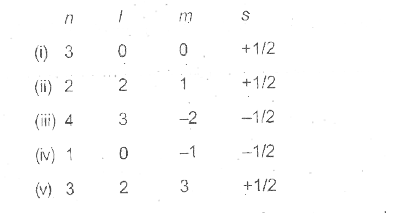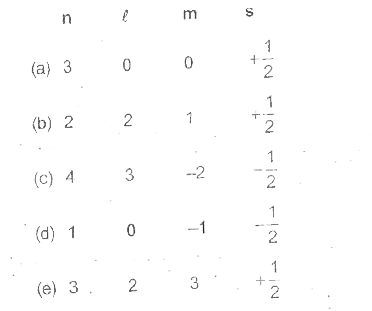Which of the following sets of quantum number is allowable
n=2,l=1,m=0,s=+1/2
n=2,l=2,m=−1,s=−1/2
n=2,l=−2,m=1,s=+1/2
n=2,l=1,m=0,s=0
The correct Answer is:A
To determine which set of quantum numbers is allowable, we need to analyze each quantum number based on the rules governing them. Quantum numbers include the principal quantum number (n), azimuthal quantum number (l), magnetic quantum number (m), and spin quantum number (s).
1. Identify the Principal Quantum Number (n):
- The principal quantum number (n) can take any positive integer value (1, 2, 3,...).
- In the given options, we have n = 2. This is valid for all options.
2. Determine the Azimuthal Quantum Number (l):
- The azimuthal quantum number (l) can take integer values from 0 to (n-1).
- Since n = 2, l can be 0 or 1 (i.e., l = 0, 1).
- Check each option for l:
- If l = 1: This is valid.
- If l = 2: This is invalid (as it exceeds n-1).
- If l = -2: This is invalid (l cannot be negative).
- If l = 0: This is valid.
3. Evaluate the Magnetic Quantum Number (m):
- The magnetic quantum number (m) can take values from -l to +l.
- For l = 1, m can be -1, 0, or +1.
- Check each option for m:
- If m = 0: This is valid.
- If m = 1: This is valid.
- If m = -1: This is valid.
- Any value outside this range is invalid.
4. Assess the Spin Quantum Number (s):
- The spin quantum number (s) can only be +1/2 or -1/2.
- Check each option for s:
- If s = +1/2: This is valid.
- If s = -1/2: This is valid.
- If s = 0: This is invalid.
5. Conclusion:
- After analyzing all quantum numbers, we can conclude that the only valid set of quantum numbers is the one that adheres to the rules outlined above. Therefore, the correct option is the one that has:
- n = 2
- l = 0 or 1
- m = -1, 0, or +1
- s = +1/2 or -1/2
Final Answer:
The correct option is option number 1 (assuming it meets the criteria above).
- The principal quantum number (n) can take any positive integer value (1, 2, 3,...).
- In the given options, we have n = 2. This is valid for all options.
- The azimuthal quantum number (l) can take integer values from 0 to (n-1).
- Since n = 2, l can be 0 or 1 (i.e., l = 0, 1).
- Check each option for l:
- If l = 1: This is valid.
- If l = 2: This is invalid (as it exceeds n-1).
- If l = -2: This is invalid (l cannot be negative).
- If l = 0: This is valid.
- The magnetic quantum number (m) can take values from -l to +l.
- For l = 1, m can be -1, 0, or +1.
- Check each option for m:
- If m = 0: This is valid.
- If m = 1: This is valid.
- If m = -1: This is valid.
- Any value outside this range is invalid.
- The spin quantum number (s) can only be +1/2 or -1/2.
- Check each option for s:
- If s = +1/2: This is valid.
- If s = -1/2: This is valid.
- If s = 0: This is invalid.
- After analyzing all quantum numbers, we can conclude that the only valid set of quantum numbers is the one that adheres to the rules outlined above. Therefore, the correct option is the one that has:
- n = 2
- l = 0 or 1
- m = -1, 0, or +1
- s = +1/2 or -1/2
The correct option is option number 1 (assuming it meets the criteria above).
Topper's Solved these Questions
- ATOMIC STRUCTUREBOOK - CENGAGE CHEMISTRY ENGLISHCHAPTER - ATOMIC STRUCTUREEXERCISE - Exercises Assertion And Reason
21 Videos
- ATOMIC STRUCTUREBOOK - CENGAGE CHEMISTRY ENGLISHCHAPTER - ATOMIC STRUCTUREEXERCISE - Exercises Integer
11 Videos
- ATOMIC STRUCTUREBOOK - CENGAGE CHEMISTRY ENGLISHCHAPTER - ATOMIC STRUCTUREEXERCISE - Exercises Multiple Correct
45 Videos
- APPENDIX - INORGANIC VOLUME 1BOOK - CENGAGE CHEMISTRY ENGLISHCHAPTER - APPENDIX - INORGANIC VOLUME 1EXERCISE - chapter-7 Single correct answer
1 Videos
- CHEMICAL BONDING AND MOLECULAR STRUCTUREBOOK - CENGAGE CHEMISTRY ENGLISHCHAPTER - CHEMICAL BONDING AND MOLECULAR STRUCTUREEXERCISE - Archives Subjective
15 Videos
Similar Questions
Consider the following sets of quantum number

Which of the following sets of quantum number is not possible ?
View SolutionConsider the following sets of quantum numbers

which of the following sets of quantum number is not possible ?
View SolutionWhich of the following sets of quantum number is not possible
View SolutionWhich of the following sets of quantum number is not possible
View SolutionWhich one of the following sets of quantum number is possible for electron in a 4f- orbital?
View SolutionWhich of the following set of quantum number is possible ?
View SolutionWhich of the following set of quantum numbers is not valid.
View Solutionwhich of the following set of quantum numbers is impossible for an electron?
View SolutionWhich of the following sets of quantum number is //are not perrmitted ?
View SolutionWhich of the following set of quantum numbers is an impossible arrangement ?
View Solution
